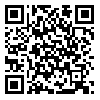Volume 8 - Special Issue
Health in Emergencies and Disasters Quarterly 2023, 8 - Special Issue: 223-232 |
Back to browse issues page
Download citation:
BibTeX | RIS | EndNote | Medlars | ProCite | Reference Manager | RefWorks
Send citation to:



BibTeX | RIS | EndNote | Medlars | ProCite | Reference Manager | RefWorks
Send citation to:
Moslehi S, Dehghani A, Masoumi G, Sheikhi R A, Barghi Shirazi F. The Role of the Mosque as an Emergency Shelter in Disasters: A Systematic Review. Health in Emergencies and Disasters Quarterly 2023; 8 :223-232
URL: http://hdq.uswr.ac.ir/article-1-402-en.html
URL: http://hdq.uswr.ac.ir/article-1-402-en.html
Shandiz Moslehi1 

 , Arezoo Dehghani2
, Arezoo Dehghani2 

 , Gholamreza Masoumi3
, Gholamreza Masoumi3 

 , Rahim Ali Sheikhi4
, Rahim Ali Sheikhi4 

 , Fahimeh Barghi Shirazi
, Fahimeh Barghi Shirazi 

 5
5


 , Arezoo Dehghani2
, Arezoo Dehghani2 

 , Gholamreza Masoumi3
, Gholamreza Masoumi3 

 , Rahim Ali Sheikhi4
, Rahim Ali Sheikhi4 

 , Fahimeh Barghi Shirazi
, Fahimeh Barghi Shirazi 

 5
5
1- Health Management and Economics Research Center, Health Management Research Institute, Iran University of Medical Sciences, Tehran, Iran.
2- Department of Health in Disasters and Emergencies, School of Public Health and Safety, Shahid Beheshty University of Medical Sciences, Tehran, Iran.
3- Department of Health in Emergencies and Disasters, School of Health Management and Information Services, Iran University of Medical Sciences, Tehran, Iran.
4- Community-oriented Nursing Midwifery Research Center, Shahrekord University of Medical Sciences, Shahrekord, Iran.
5- Department of Health in Disasters and Emergencies, School of Health Management and Information Sciences, Iran University of Medical Sciences, Tehran, Iran. , fshirazi63@gmail.com
2- Department of Health in Disasters and Emergencies, School of Public Health and Safety, Shahid Beheshty University of Medical Sciences, Tehran, Iran.
3- Department of Health in Emergencies and Disasters, School of Health Management and Information Services, Iran University of Medical Sciences, Tehran, Iran.
4- Community-oriented Nursing Midwifery Research Center, Shahrekord University of Medical Sciences, Shahrekord, Iran.
5- Department of Health in Disasters and Emergencies, School of Health Management and Information Sciences, Iran University of Medical Sciences, Tehran, Iran. , fshirazi63@gmail.com
Abstract: (1144 Views)
Background: Providing emergency shelter for disaster victims is a part of disaster risk mitigation strategies. International organizations have proposed a framework for appropriate planning and emergency shelter design. These agencies are encouraging local authorities to manage events to use existing structures such as schools, community centers, etc., as emergency shelters for the victims. According to the social religious and spiritual status of mosques in communities, these centers are one of the crucial elements to create a safe and trusted shelter during disasters. This study aims to identify the role of mosques as emergency shelters in disasters.
Materials and Methods: This study was a systematic study that searched the words related to the research title (disaster management, emergency shelter, mosque) with AND, OR operators in PubMed, Web of Sciences, Science Direct, and Scopus databases, and the Google scholar search engine, as well as Persian language databases of SID, Magiran, Irandoc, and Iran Medex. A three-step screening process was used to select studies using the Preferred Reporting Items for Systematic Reviews And Meta-Analyses (PRISMA) checklist. Finally, the data were analyzed thematically.
Results: Out of a total of 175 articles found, 6 articles were relevant to the purpose of the study and were analyzed. The results of the present study showed that mosques can be suitable shelters for risk management during accidents and disasters. Also, in this regard, a range of strategies for designing programs for public participation and mosques were identified.
Conclusion: The services and the role of mosques in disaster occurrence as a shelter are very effective and these valuable services can be further extended using social capital, attracting the attention of religious institutions, and public participation.
Materials and Methods: This study was a systematic study that searched the words related to the research title (disaster management, emergency shelter, mosque) with AND, OR operators in PubMed, Web of Sciences, Science Direct, and Scopus databases, and the Google scholar search engine, as well as Persian language databases of SID, Magiran, Irandoc, and Iran Medex. A three-step screening process was used to select studies using the Preferred Reporting Items for Systematic Reviews And Meta-Analyses (PRISMA) checklist. Finally, the data were analyzed thematically.
Results: Out of a total of 175 articles found, 6 articles were relevant to the purpose of the study and were analyzed. The results of the present study showed that mosques can be suitable shelters for risk management during accidents and disasters. Also, in this regard, a range of strategies for designing programs for public participation and mosques were identified.
Conclusion: The services and the role of mosques in disaster occurrence as a shelter are very effective and these valuable services can be further extended using social capital, attracting the attention of religious institutions, and public participation.
Type of Study: Review |
Subject:
General
Received: 2021/11/2 | Accepted: 2022/03/6 | Published: 2023/04/18
Received: 2021/11/2 | Accepted: 2022/03/6 | Published: 2023/04/18
Send email to the article author
| Rights and permissions | |
 |
This work is licensed under a Creative Commons Attribution-NonCommercial 4.0 International License. |





